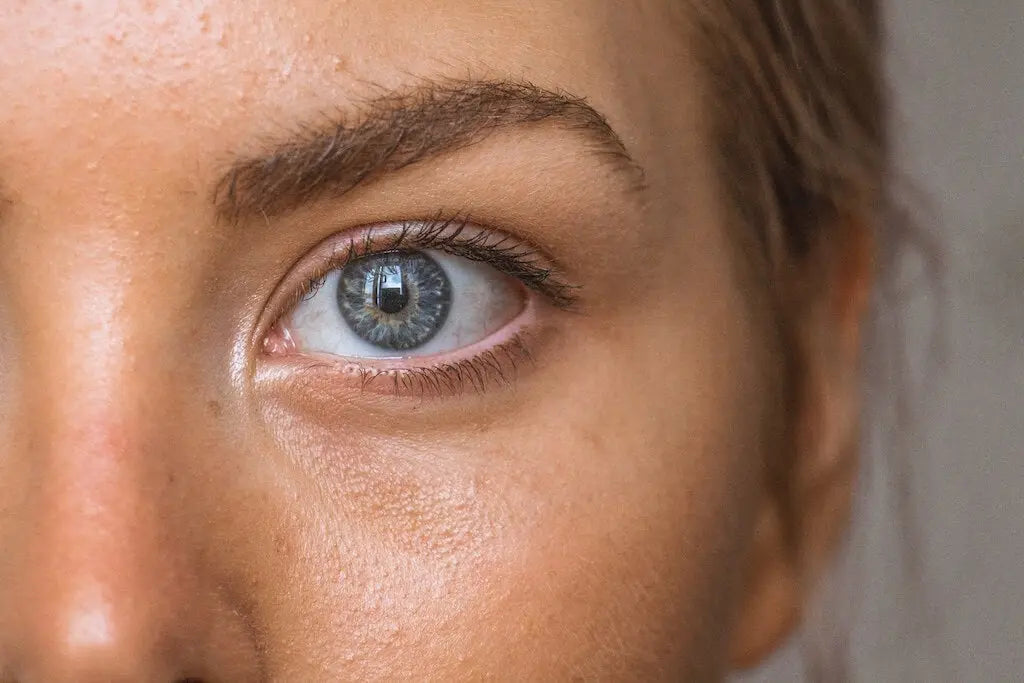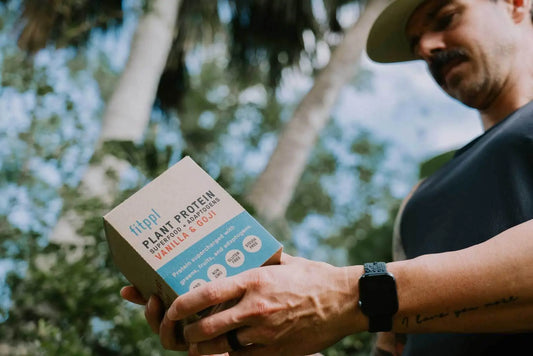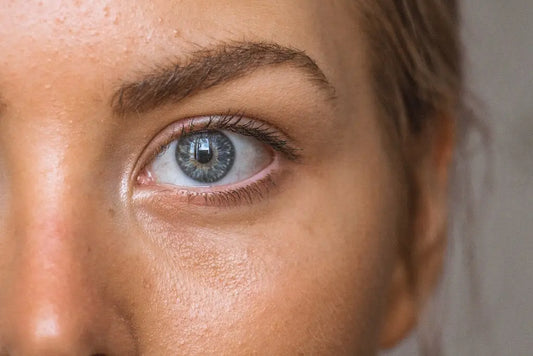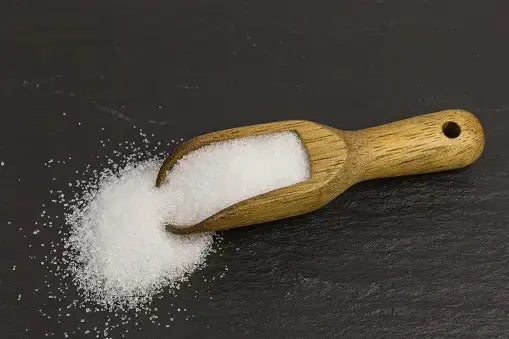Can Whey Protein Cause Acne? The Ultimate Guide for Clear Skin

Battling pesky skin breakouts but can’t figure out why?
Maybe you keep spending money on one skincare product after the next.
Expensive cleansers, face masks, harsh scrubs, acids, you name it – yet the acne isn’t budging.
But what if the answer wasn’t skincare at all?
What if the answer was in your protein shake?
Taylor Stolt, Functional Medicine Dietitian and hormone expert, unravels the connection between whey protein and your acne breakouts in this blog post.
In this article you’ll learn
- What whey protein is, how it was discovered, and how it’s made
- Different types of whey protein
- The link between whey protein and acne
- What does acne from whey protein look like?
- Does whey protein cause acne for everyone?
- Why plant-based protein could be the answer you’ve been searching for
- What to look for in a plant-based protein powder
- Nutrients and supplements to consider to boost skin health alongside plant protein
- Other common causes of acne
- Benefits of a personalized approach to your skin health
THE SCOOP ON WHEY PROTEIN
What is Whey Protein?
Whey protein is a dairy-based protein that comes from cow’s milk.
It comes in powdered form and is often added to water, milk, or alternative milks in the form of a protein “shake”.
Sometimes whey protein is pre-mixed with a liquid in the form of a ready-to-drink bottled protein shake.
Some people also add whey protein to smoothies, yogurts, baked goods, and other recipes to boost its protein content.
How was whey discovered?
We think whey protein was accidentally discovered around 3000 years ago.
Farmers used cow stomach to transport fresh milk, but the enzymes in the stomach would cause the milk to curdle (thicken) and it would leave just the liquid whey behind.
People started drinking the liquid whey, and Hippocrates, a Greek Physician considered to be the father of modern medicine, even prescribed it as part of his treatments in some cases.
How is whey protein made?
First, cow’s milk is heated to super high temperatures then instantly cooled to kill harmful bacteria, a process referred to as pasteurization.
After the milk is pasteurized, the milk contains about 20% whey protein and 80% casein protein.
Then enzymes are added to the milk, which separates out the liquid whey. The solids are collected and turned into cheese, and the liquid whey undergoes even more processing.
Liquid whey is concentrated and the liquid is put into a dryer that uses both hot and cold air to dry out the water and form a powder.
After the whey protein powder is made, ingredients like flavors, sweeteners, thickeners, and preservatives are often added.
TYPES OF WHEY PROTEIN
There are three main types of whey protein powder – whey protein concentrate, whey protein isolate, and whey protein hydrolysate.
All three types come from cow’s milk, and all three types undergo the processing described above with just slight variations.
Whey protein concentrates undergo the least amount of processing, exactly as described in the previous section. This whey protein still contains some natural sugars, in the form of lactose, and some fat.
Whey protein isolates go through additional processing to remove most of the lactose and fat, leaving mostly protein behind.
Some companies use heat, acid, enzymes, or a combination of techniques to break down the protein bonds in whey protein to make the protein easier to absorb. This easier-to-absorb protein is referred to as whey protein hydrolysate. Whey is already easy to absorb to begin with, yet this small tweak usually comes with a hefty price tag.
All three types of whey protein pose the same challenges when it comes to clear skin. Want to learn more? Keep reading!
LINKING WHEY TO SKIN TROUBLES: THE ACNE CONNECTION
THE LINK BETWEEN WHEY PROTEIN AND ACNE
To examine the relationship between acne and whey protein, it’s helpful to start with the link between dairy and acne.
Several studies have shown dairy can increase a hormone called insulin like growth factor 1 (IGF-1). It’s clear that high levels of IGF-1 from dairy products can negatively impact our skin in several ways.
IGF-1 increases sebum production. Sebum is the oil on the skin that can lead to blocked pores and acne if produced in excess.
IGF-1 can also increase inflammatory markers, and inflammation is a driving factor for acne.
Research even shows high levels of IGF-1 is linked to worse post-acne scarring.
Another way dairy could be linked to acne is its effect on insulin.
Research shows milk-derived proteins promote insulin production, and too much insulin over time can lead to insulin resistance.
Insulin resistance is linked to a lot of different hormonal imbalances including Polycystic Ovarian Syndrome (PCOS), all of which can contribute to acne.
Whey protein comes directly from milk, so it’s safe to assume whey protein could increase IGF-1 and insulin levels just like milk.
Pregnant Cows Year-Round
In the US, farmers keep cows pregnant so they can maximize the amount of milk they produce.
Free-range cows in other countries get pregnant naturally and are typically milked for five or six months after they give birth.
Meanwhile, in the US we get cows pregnant artificially so they have one calf a year. This means they can produce milk for about ten months every single year.
Because US cows are pregnant 75% of the time (cows are pregnant for 9 months just like humans), their hormone levels are high the majority of the time too.
For example, milk from pregnant cows contains up to 500 times more estrogen as the cow gets close to giving birth!
ARE HUMANS AFFECTED BY HORMONES IN MILK?
These high levels of hormones in milk appear to affect us when we drink it.
A 2010 research study looked at various hormone levels in men, women, and children after consuming milk.
The men drank milk and then did blood tests to look at how their hormone levels responded.
The children drank milk and then collective urine samples to see how their hormone levels were affected.
Women were told to drink two cups of milk a day for 21 days, and markers of ovulation were tracked to see if the milk would affect their ovulation timing.
In men, estrogen and progesterone levels significantly increased, peaking around 30-60 minutes after drinking the milk. They also saw decreases in testosterone around 2 hours after milk consumption.
In children, they saw an increase in hormones, peaking 1-3 hours after they drank the milk.
In women, only one of the five women experienced a change in ovulation timing.
But keep in mind, that doesn’t mean the milk wasn’t impacting their hormones. Ovulation timing is just one marker of hormone balance. And we might have seen changes in ovulation timing if the women had continued to drink two cups of milk per day.
The milk changed hormone levels for the men and kids, so it was probably changing the women’s hormone levels too.
With that being said, it’s important to pay attention to research studies to keep things in perspective.
A closer look at the research methods shows the men drank a lot of milk – four to five cups based on their body weight. The children drank quite a bit as well – two to three cups, also based on their weight.
So would one whey protein shake a day affect your hormone levels?
Maybe.
If you’re having trouble with your hormones or hormonal acne, does it make sense to cut it out for a period of time to see if it helps? I would argue a big fat yes.
IS THERE RESEARCH ON WHEY PROTEIN AND ACNE?
There are!
Several research studies show a dramatic increase in acne for people taking whey protein.
In one study, 43% of participants had no acne and 50% had very mild acne at the beginning of the study. After two months of using whey protein powder, no one was acne-free and only 27% had mild acne.
So we saw people with clear skin develop acne, and we also saw mild acne get more severe.


WHAT DOES ACNE FROM WHEY PROTEIN LOOK LIKE?
Acne from whey protein often shows up on the face, but it can also appear on the neck, back, and other areas of the body.
There is no research to support this – but if whey protein is causing face breakouts for my client, I typically see the acne around the mouth, chin, and jawline. Other healthcare practitioners have confirmed they see this pattern too.
Breakouts could be whiteheads or blackheads, but they can also be more inflamed forms of acne like papules, pastures, or cysts.
DOES WHEY PROTEIN CAUSE ACNE FOR EVERYONE?
Does whey protein cause acne for everyone?
The million-dollar question: Does whey protein cause acne for everyone?
Nope!
Like with any food, reactions vary.
Acne-prone skin and a family history of acne means you could be more prone to breaking out if you eat certain foods.
But just because you don’t have acne-prone skin or a family history doesn’t mean you have nothing to worry about – anyone can suffer from whey-induced breakouts.
I’ve had some clients who can drink whey protein shakes without any skin issues, and I’ve had (many) clients whose acne dramatically improves once they swap out their whey protein shakes.
I’m always telling the women I work with to listen to their body and their body only.
It doesn’t matter what works for your coworker, roommate, partner, trainer, or favorite Instagram influencer.
What matters is what works for you!
WHY PLANT-BASED PROTEINS COULD BE THE ANSWER TO YOUR ACNE
Plant protein powder for clear skin
If whey is the culprit, what’s the alternative? Enter plant-based proteins.
Popular plant-based protein alternatives include pea protein, hemp protein, and rice protein.
These whey protein alternatives have gained momentum for good reasons.
If you choose the right type of plant-based protein (more guidance on that later) you get the benefits of protein powder without the downsides.
Plant-based proteins are dairy-free, which means they won’t cause increases in IGF-1 or insulin like whey protein can.
Normal levels of IGF-1 and insulin means more balanced hormones, normalized oil production, less skin inflammation, and healthier, clearer skin.
HOW LONG BEFORE I SEE IMPROVEMENTS IN MY ACNE?
Improvements vary person to person, from just a couple of weeks to months.
I’ve seen some client’s skin clear in just a couple of weeks once they cut out their whey protein powder, but I’ve also seen some clients take two months.
Our skin cells constantly shed, which reveals new, fresh skin cells underneath. For the average adult, it takes between 40 and 56 days for our skin to turnover. This is why it takes time for scars and blemishes to fade.
I recommend cutting out whey protein for at least 2 months, one full skin cycle, to see if it clears up your skin.
HOW TO MAKE THE SWITCH FROM WHEY TO PLANT-BASED PROTEIN
Switching sounds easy, right?
Not quite!
Not all plant-based protein powders are created equal.
A lot of plant-based protein powders contain ingredients that could leave your skin just as acne-filled as whey protein powder.
What to look for in a plant-based protein powder
Instead of falling for marketing schemes like Instagram ads or healthy-looking packaging, take a careful look at the ingredients and do some online research to make sure the product is legit.
The best plant-based protein options will meet all of the following criteria:
- All nine essential amino acids
- No artificial sugars
- No added sugar
- No artificial flavors
- No emulsifiers (sunflower lecithin, soy lecithin, carrageenan, etc.)
- No gums (gellan gum, guar gum, arabic gum, xanthan gum, etc.)
- Third-party testing for heavy metals and other contaminants
Nutrients and supplements to boost skin health alongside plant proteins
There are many nutrients that you can use to support healthy skin alongside plant protein.
Some favorites include omega-3’s, zinc, vitamin D, vitamin A, and vitamin E.
Make sure you get your supplements from a reputable source, not Amazon, so you can ensure you’re getting the real thing.
When possible, work with a healthcare practitioner you trust. They can give you personalized recommendations, access to safe and effective third-party tested supplements, and instructions on how to take them.
OTHER COMMON CAUSES OF ACNE
Imbalanced sex hormones
As a hormone expert, I’ve seen many hormonal patterns cause my clients’ acne.
High androgens like testosterone are a common cause of hormonal acne in women. This is common in PCOS and typically presents as acne along the jawline, chin, and around the mouth. Other signs of high androgens to watch out for include irregular periods, hair loss, and hirsutism (dark hair growth on the face).
Other common hormonal causes of acne include estrogen dominance, low estrogen, low progesterone, and low thyroid hormone production.
Not sure if your hormones are imbalanced? Take this free quiz to find out!
Chronic Dehydration
If our body is dehydrated, our skin is dehydrated.
Not drinking enough water can dry out your skin and cause skin congestion,, which leads to more acne breakouts.
Inflammation
Some researchers argue acne is a mainly “inflammatory disease”.
Inflammation could come from dairy products, and other common causes include a low omega-3 intake, high omega-6 intake, and blood sugar imbalances.
Blood sugar roller coaster
Speaking of blood sugar imbalances – Insulin is another important hormone that can contribute to acne.
Insulin is the hormone responsible for managing our blood sugar levels. Chronically elevated insulin, as in insulin resistance (or “pre-diabetes”) can contribute to acne.
Gut bacteria imbalances and “leaky gut”
You may have heard of the gut-brain axis (the connection between our gut and our brain), but have you heard of the gut-skin axis?
Imbalances in our gut bacteria and increased intestinal permeability aka “leaky gut” can both negatively affect our skin and cause breakouts.
Stress
If you feel like you break out more when you’re stressed, it’s not in your head.
Many research studies show mental/emotional stress can cause acne, worsen existing acne, and slow down the healing process.
Supplements
Some supplements can actually make acne worse. The two most common supplements I see this happen with are high dose B12 and high dose biotin.
Nutrient Deficiencies
Research shows deficiencies in nutrients like vitamin D, vitamin A, zinc, selenium, vitamin E, and specific B vitamins can cause acne.
CARING FOR YOUR SKIN DURING THE TRANSITION
A simple skincare routine that includes a gentle cleanser, gentle chemical exfoliant, and moisturizer will help clear pores while keeping your skin hydrated. Less is often more.
I know it’s easier said than done, but don’t pick! Picking at your acne can spread bacteria and make your acne worse, it could result in an infection, and it inflicts trauma to the skin which increases your risk for your scars.
CONCLUSION
When we look closely at whey protein and its possible connection to acne, we see that skincare isn’t just about the cleansers and creams we use.
What we eat matters too.
While whey protein might not be the culprit for everyone, it’s clear that for some, making the switch to plant-based proteins could mean clearer skin.
If you think whey protein might be affecting your skin, try using plant-based proteins and see how your skin responds.
Always prioritize listening to your body and finding what works for you.
If your acne seems to be caused by more than just whey protein, consult a professional who can provide answers and guidance.
The journey to radiant skin might just start with what’s on your plate or in your shake!









